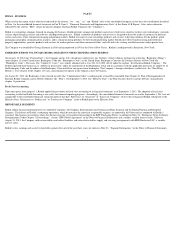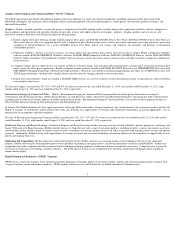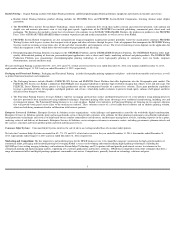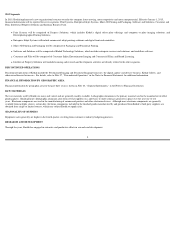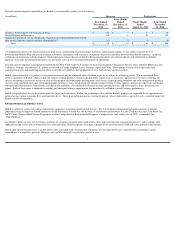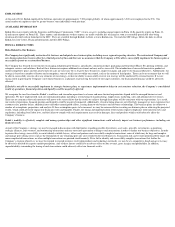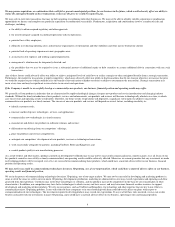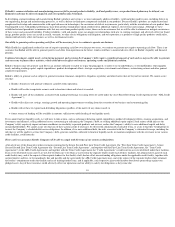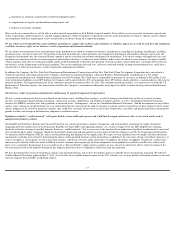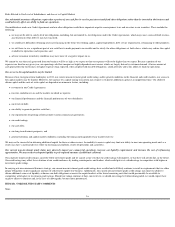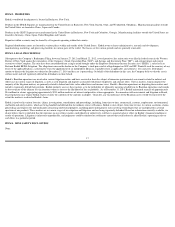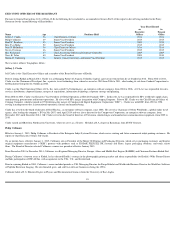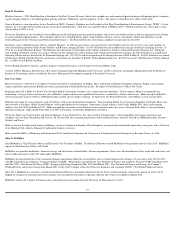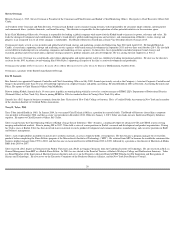Kodak 2014 Annual Report Download - page 14
Download and view the complete annual report
Please find page 14 of the 2014 Kodak annual report below. You can navigate through the pages in the report by either clicking on the pages listed below, or by using the keyword search tool below to find specific information within the annual report.
Business disruptions could seriously harm our future revenue and financial condition and increase our costs and expenses.
Our worldwide operations could be subject to earthquakes, power shortages, telecommunications failures, cyber-attacks, terrorism, water shortages, tsunamis, floods,
hurricanes, typhoons, fires, extreme weather conditions, medical epidemics, political or economic instability, and other natural or manmade disasters or business interruptions,
for which we are predominantly self-insured. The occurrence of any of these business disruptions could seriously harm our revenue and financial condition and increase our
costs and expenses. In addition, some areas, including parts of the east and west coasts of the United States, have previously experienced, and may experience in the future,
major power shortages and blackouts. These blackouts could cause disruptions to our operations or the operations of our suppliers, distributors and resellers, or customers. We
have operations including research and development facilities in geographically disparate locations, such as Israel, Japan, China and Canada. The impact of these risks is
greater in areas where products are manufactured at a sole or limited number of location(s), and where the sourcing of materials is limited to a sole or limited base of suppliers,
since any material interruption in operations in such locations or suppliers could impact our ability to provide a particular product or service for a period of time. These events
could seriously harm our revenue and financial condition, and increase our costs and expenses.
If we cannot protect the intellectual property rights on which the Company
’
s business depends, or if third parties assert that we violate their intellectual property rights,
our revenue, earnings, expenses and liquidity may be adversely impacted.
A key differentiator for Kodak in many of our businesses is our technological advantage over competitors’ products and solutions. Our technological advantage is supported
by Kodak’s intellectual property rights. Patent, copyright, trademark and trade secret laws in the United States and similar laws in other countries, and non-disclosure,
confidentiality and other types of agreements with Kodak’s employees, customers, suppliers and other parties, may not be effective in establishing, maintaining and enforcing
Kodak’s intellectual property rights. Any of Kodak’s direct or indirect intellectual property rights could be challenged, invalidated, circumvented, infringed or
misappropriated, or such intellectual property rights may not be sufficient to permit us to take advantage of current market trends or otherwise to provide competitive
advantages, which could result in costly product redesign efforts, discontinuance of certain product offerings or other competitive harm. Further, the laws of certain countries
do not protect proprietary rights to the same extent as the laws of the United States. Therefore, in certain jurisdictions, we may be unable to protect Kodak’s proprietary
technology adequately against unauthorized third party copying, infringement or use, which could adversely affect our competitive position. Also, because of the rapid pace of
technological change in the information technology industry, much of Kodak’s business and many of Kodak’
s products rely on key technologies developed or licensed by third
parties, and we may not be able to obtain or continue to obtain licenses and technologies from these third parties at all or on reasonable terms.
We have made substantial investments in new, proprietary technologies and have filed patent applications and obtained patents to protect Kodak’s intellectual property rights
in these technologies as well as the interests of Kodak’s licensees. There can be no assurance that Kodak’s patent applications will be approved, that any patents issued will
adequately protect Kodak’s intellectual property or that such patents will not be challenged by third parties.
In addition, third parties may claim that Kodak’s customers, licensees or other parties indemnified by us are infringing upon their intellectual property rights. Such claims may
be made by competitors seeking to block or limit our access to certain markets. Additionally, in recent years, individuals and groups have begun purchasing intellectual
property assets for the sole purpose of making claims of infringement and attempting to extract settlements from large companies like ours. Even if we believe that the claims
are without merit, these claims may have the following negative impacts on our business:
Finally, we use open source software in connection with our products and services. Companies that incorporate open source software into their products have, from time to
time, faced claims challenging the ownership of open source software and/or compliance with open source license terms. As a result, the Company could be subject to suits by
parties claiming ownership of what we believe to be open source software or noncompliance with open source licensing terms. Some open source software licenses require
users who distribute open source software as part of their software to publicly disclose all or part of the source code to such software and/or make available any derivative
works of the open source code on unfavorable terms or at no cost; any requirement to disclose the Company’s source code or pay damages for breach of contract could be
harmful to our business results of operations and financial condition.
•
claims can be time consuming and costly to defend and may distract management’s attention and resources;
•
claims of intellectual property infringement may require us to redesign affected products, enter into costly settlement or license agreements or pay costly damage
awards, or face a temporary or permanent injunction prohibiting us from marketing or selling certain of our products;
•
even if we have an agreement to indemnify us against such costs, the indemnifying party may be unable to uphold its contractual obligations; and
•
if we cannot or do not license the infringed technology at all, license the technology on reasonable terms or substitute similar technology from another source, our
revenue and earnings could be adversely impacted.
13


